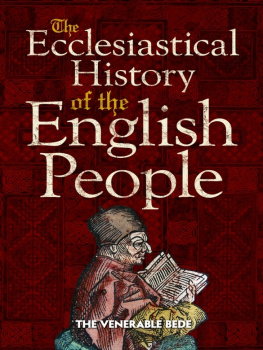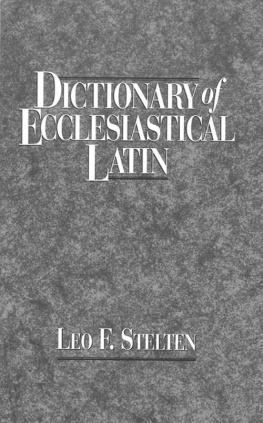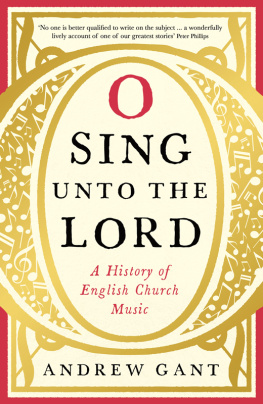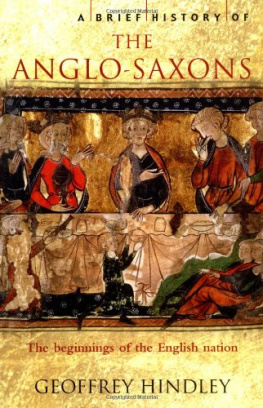
ECCLESIASTICAL HISTORY OF THE ENGLISH PEOPLE
ADVISORY EDITOR: BETTY RADICE
Bede was born in 673. He himself tells us that he became a monk at an early age and lived most of his life at Jarrow. Scholar, teacher and writer, he wrote biblical and other works. He has been described as the Father of English History. His historical works include Life of Cuthbert and Lives of the Abbots of Wearmouth and Jarrow, both in The Age of Bede (a Penguin Classic). Bede died in 735.
Leo Sherley-Price served in the Royal Navy for twenty-seven years, his last appointment being with the Royal Naval College, Greenwich. Subsequently he has been Rural Dean and parish priest in Devon. He has translated Thomas Kempis Imitation of Christ, Walter Hiltons The Ladder of Perfection, The Little Flowers of Saint Francis and a number of other historical and theological books. He is now retired and is Honorary Assistant priest at the church of St John the Evangelist, Bovey Tracey, in Newton Abbot, Devon, and he remains in active ministry.
D. H. Farmer (B.Litt. Oxon) was Reader in History at Reading University until 1988. He is author and editor of several books on ecclesiastical and monastic history such as Benedicts Disciples (2nd edition, 1999), The Age of Bede (a Penguin Classic, 1983), St Hugh of Lincoln (3rd edition, 2000) and The Oxford Dictionary of Saints (1978; 4th edition, 1997). This has been translated into Italian, Slovakian and Roumanian. A work on Anglo-Saxon missionaries in Europe is in preparation. He has also been principal consultant for the new twelve-volume edition of Butlers Lives of the Saints (19959).

BEDE

ECCLESIASTICAL HISTORY
OF THE
ENGLISH PEOPLE
WITH
BEDES LETTER TO EGBERT
AND
CUTHBERTS LETTER
ON THE DEATH OF BEDE

The History translated by
Leo Sherley-Price
revised by R. E. Latham
Translation of the minor works,
new Introduction and Notes
by D. H. Farmer
PENGUIN BOOKS
PENGUIN BOOKS
Published by the Penguin Group
Penguin Books Ltd, 80 Strand, London WC2R 0RL, England
Penguin Putnam Inc., 375 Hudson Street, New York, New York 10014, USA
Penguin Books Australia Ltd, 250 Camberwell Road, Camberwell, Victoria 3124, Australia
Penguin Books Canada Ltd, 10 Alcorn Avenue, Toronto, Ontario, Canada M4V 3B2
Penguin Books India (P) Ltd, 11 Community Centre, Panchsheel Park, New Delhi 110 017, India
Penguin Books (NZ) Ltd, Cnr Rosedale and Airborne Roads, Albany, Auckland, New Zealand
Penguin Books (South Africa) (Pty) Ltd, 24 Sturdee Avenue, Rosebank 2196, South Africa
Penguin Books Ltd, Registered Offices: 80 Strand, London WC2R 0RL, England
www.penguin.com
This translation first published 1955
Reprinted with revisions 1965
Revised edition 1968
Revised edition 1990
22
Translation of Ecclesiastical History of the English People
Copyright Leo Sherley-Price, 1955, 1968
Introduction copyright D. H. Farmer, 1990
Translation of Bedes Letter to Egbert
and Cuthberts Letter on the
Illness and Death of the Venerable Bede
copyright D. H. Farmer, 1990
All rights reserved
Except in the United States of America, this book is sold subject
to the condition that it shall not, by way of trade or otherwise, be lent,
re-sold, hired out, or otherwise circulated without the publishers
prior consent in any form of binding or cover other than that in
which it is published and without a similar condition including this
condition being imposed on the subsequent purchaser
EISBN: 9781101488102
CONTENTS

BOOK FOUR
BEDES LETTER TO EGBERT
MAPS
ACKNOWLEDGEMENTS

LIKE all previous editions of Bedes Ecclesiastical History this one depends on the pioneer work of Charles Plummer in Baedae Opera Historica (Oxford, 1896 and 1956). Grateful recognition is also made to the edition and notes of B. Colgrave and R. A. B. Mynors (Oxford, 1969) and to the historical commentary by J. M. Wallace Hadrill (Oxford, 1988), which have been invaluable in providing much material for this work. Among more recent writers James Campbell, first in his essay on Bede in Latin Historians (ed. T. A. Dorey, 1966) and then in The Anglo-Saxons (1982), has placed all scholars in this field in his debt. At a late stage of preparation David Howlett and Richard Sharpe (of the Dictionary of Medieval Latin from British Sources) gave generous help, especially in the preparation of the subsidiary texts and the footnotes. For any errors none of these benefactors are responsible.
LIST OF ABBREVIATIONS

AB | J. F. Webb and D. H. Farmer, The Age of Bede (Penguin Classics 1989) |
ASE | Anglo-Saxon England (periodical, 1972) |
Campbell | J. Campbell, ed. The Anglo-Saxons (1982) |
CCSL | Corpus Christianorum Scriptorum Latinorum |
Colgrave and Mynors | B. Colgrave and R. A. B. Mynors, Bedes Ecclesiastical History (Oxford 1969) |
EHD I | D. Whitelock, ed., English Historical Documents, vol. I (1968) |
Famulus Christi | G. Bonner, ed., Famulus Christi (1976) |
Kirby | D. P. Kirby, ed., St Wilfrid at Hexham (Newcastle 1974) |
ODS | D. H. Farmer, The Oxford Dictionary of Saints (Oxford 1987) |
ODCC | F. L. Cross and E. A. Livingstone, The Oxford Dictionary of the Christian Church (Oxford 1974) |
PBA | Proceedings of the British Academy |
Plummer | C. Plummer, Bedae Opera Historica (Oxford 1956) |
WH | J. M. Wallace Hadrill,Bedes Ecclesiastical History: a Historical Commentary (Oxford 1988) |
INTRODUCTION

BEDES History, the first account of Anglo-Saxon England ever written, has always been highly esteemed. Bede was a monk of Jarrow who worked on this book for several years before completing it in 731. Over the next fifty years it was copied in Northumbria and elsewhere (four eighth-century manuscripts survive), and it became widely diffused in western Europe throughout the Middle Ages. It was first printed in c. 1480 and nowadays it enjoys a wider distribution than ever before.
The History is readable and attractive. Whether he writes of the geography of Britain (i. 1), the coming of Augustine (i. 26), the Northumbrian council concerned with the acceptance of Christianity (ii. 13) or the achievements of Abbess Hilda and the poet Caedmon (iv. 234), Bedes insight, empathy and concision are evident. Elsewhere his descriptions of natural phenomena such as the recovery of a horse from illness (ii. 9), the speech therapy provided for a boy (v. 2) and the supernatural experiences of the visionary Drythelm (v. 12) reveal his talent as a descriptive writer. Even more important, his power of synthesis, making a coherent whole from fragmentary elements, together with his telling use of original sources, make him a fine historian.












